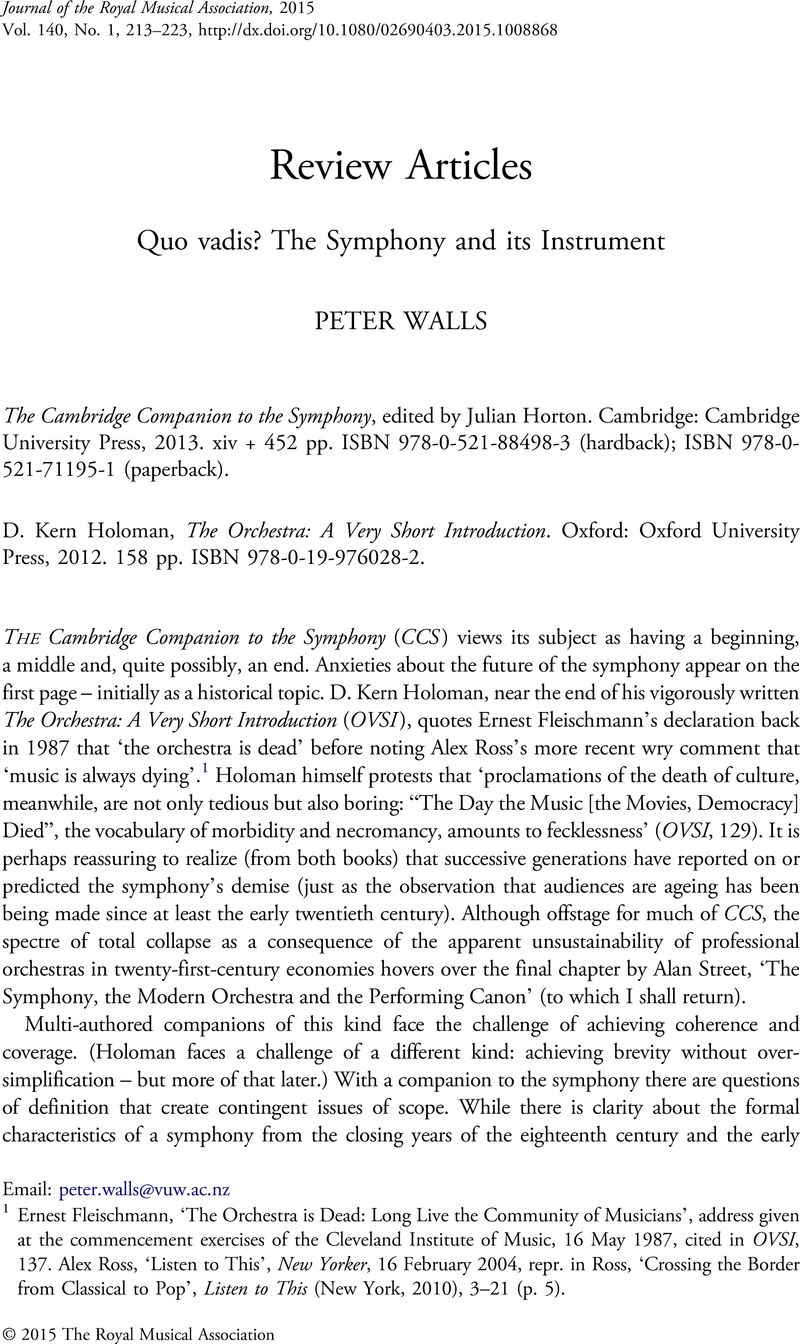No CrossRef data available.
Article contents
Quo vadis? The Symphony and its Instrument
Published online by Cambridge University Press: 01 January 2020
Abstract

- Type
- Review Articles
- Information
- Copyright
- Copyright © 2015 The Royal Musical Association
References
1 Ernest Fleischmann, ‘The Orchestra is Dead: Long Live the Community of Musicians’, address given at the commencement exercises of the Cleveland Institute of Music, 16 May 1987, cited in OVSI, 137. Alex Ross, ‘Listen to This’, New Yorker, 16 February 2004, repr. in Ross, ‘Crossing the Border from Classical to Pop’, Listen to This (New York, 2010), 3–21 (p. 5).
2 Carl Dahlhaus is quoted in eight of CCS's eighteen chapters, even in one instance where an unmediated translation produces something that is just not English – the idea that around 1802 there emerges ‘musical thinking that is directed to radical processuality of form’ (p. 177). Horton notes Dahlhaus's ‘covert prejudice’ against non-German symphonies (p. 211), but otherwise he is invoked for his useful conceptual frameworks. It is remarkable that this thinker can still exert such a dominant influence on English-language musicology three decades after his last publication. By comparison, Theodor Adorno makes an appearance on page 1 of CCS, a reference that is recalled in the volume's closing pages. Daniel Grimley also cites Adorno approvingly in claiming that the multi-vocality of twentieth-century symphonic writing mirrors the fractured character of the modern world. Dahlhaus emerges as the master of the grand narrative, while Adorno's enduring role is that of an alternately brilliant or eccentric agent provocateur.
3 H. C. Robbins Landon and David Wyn Jones, Haydn: His Life and Music (London, 1988), 143.
4 Letter dated 20 June 1790 from Haydn in Esterháza to Maria Anna von Genzinger in Vienna. Joseph Haydn: Gesammelte Briefe und Aufzeichnungen, ed. Dénes Bartha and H. C. Robbins Landon (Kassel, 1965), 240. English translation from H. C. Robbins Landon, Haydn: Chronicle and Works, 5 vols. (London, 1976–8), ii: Haydn at Esterháza 1766–1790 (1978), 743–4.
5 Theodor W. Adorno, ‘The Radio Symphony: An Experiment in Theory’, Essays on Music, ed. Richard Leppert, trans. Susan H. Gillespie (Berkeley, CA, 2002), 251–70.
6 Christopher Rouse gets favourable mention for his three symphonies (p. 121) and William Grant Still's ‘Afro-American’ Symphony is mentioned in passing (p. 407), but not any of his other contributions to the genre. The presence of Henry Kimball Hadley in the New York Philharmonic programmes for 1920–1 and John Harbison in the San Francisco Symphony's 2011–12 centenary season is noted by Alan Street in the final chapter.
7 These programmes are available on DVD: Leonard Bernstein's Young People's Concerts with the New York Philharmonic, Kultur D1503 (1993).
8 Joseph Kerman, ‘A Few Canonic Variations’, Critical Inquiry, 10 (1983), 107–25 (p. 107).
9 J. Peter Burkholder, ‘The Twentieth Century and the Orchestra as Museum’, The Orchestra: Origins and Transformations, ed. Joan Peyser (New York, 1986), 400–33 (p. 414).
10 For the TV commercials, see <http://www.youtube.com/watch?v=z1ALtcAO69M> (accessed 19 September 2014).
11 The numbers in the table are – with the exception of the NZSO – based on membership lists published on the orchestras’ websites sampled in mid-2013. Needless to say, the table cannot account for vacancies (two in the first violin section of the NZSO, for example, when I took my biopsy).
12 I discussed the concept of a standard orchestra in ‘Beyond Anachronism: Orchestras and Orchestration in the 21st Century’, Journal of the Royal Musical Association, 130 (2005), 302–26.




